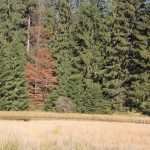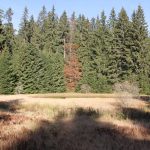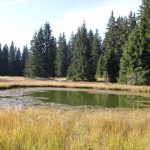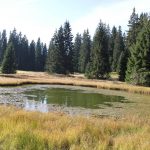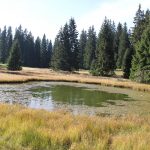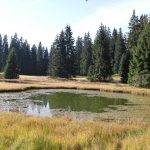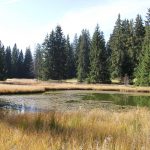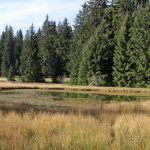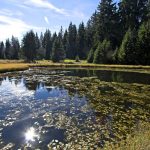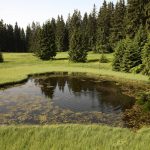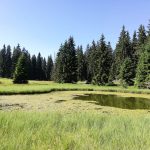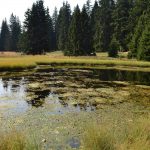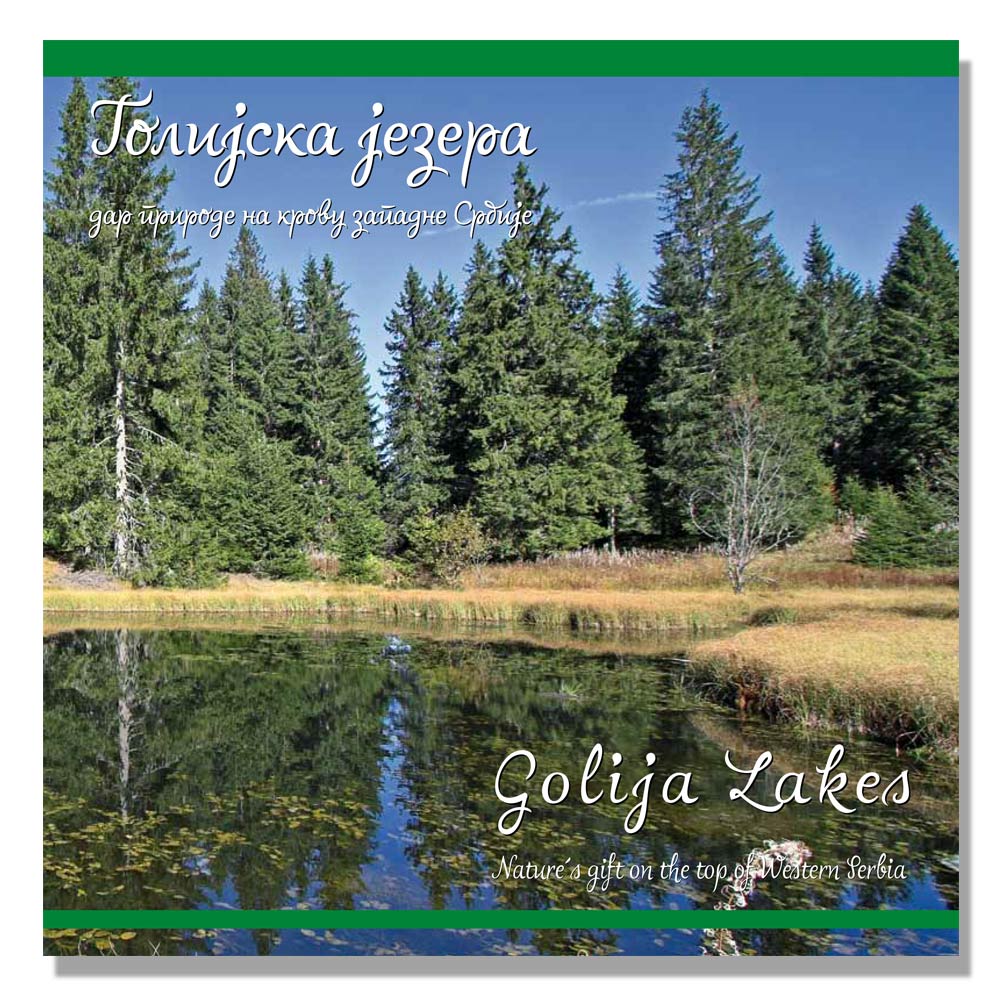Daicko lake
Daicko lake is located in the northwest side of Golija, on the mountain slope starting from the highest peak of Golija, Jankov kamen on 1833 m above sea level, down the north side of the mountain, creating the watershed between the two biggest and most popular rivers of Golija, Moravica and Studenica. In morpho- hydrological sense, it belongs to the basin of Moravica , and also is near the basin of river Studenica, since the watershed is actually the reef of river Rivotina, on the east side of the lake.
The lake is on 1436 m above sea level, in a small, shallow valley. Water surface area is aproximatelly 160 m2, with its volume of aproximately 50 m. Daicko lake is quite approachable since it is located by the road Ivanjica – Bele Vode, more precisely Ivanjica – Golijska Reka. The lake is 30 km far from Ivanica, little more than 2km from Bele Vode, and 10 km from Golijska Reka.
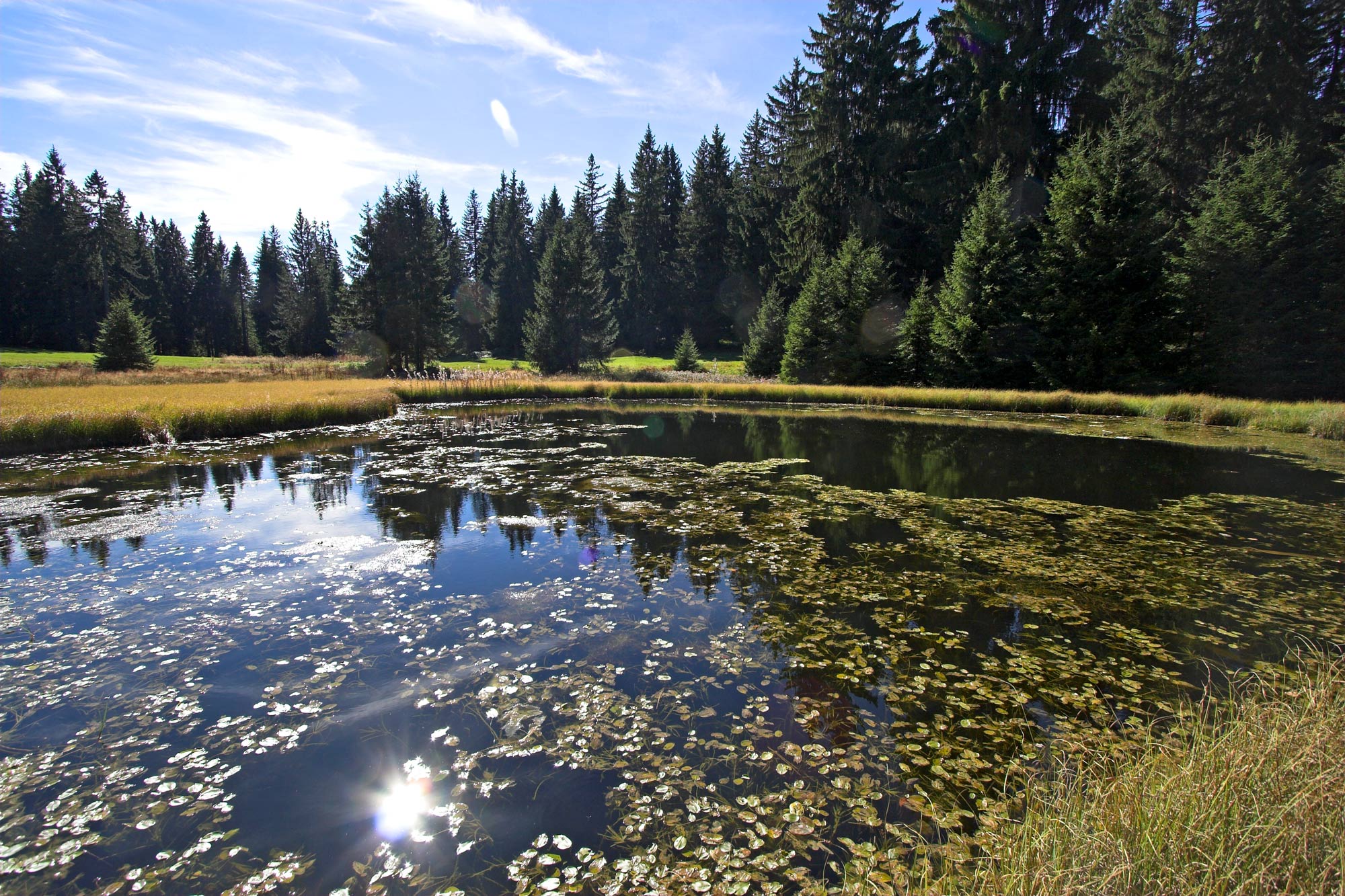
This lake is popular under name Ticar, named after the hill on its west side. Few other names, like Wedding lake or Mountain Eye of Golija are quite popular as well. Dating back the formation of the lake and how it was formed used to be rather complex issue so far and solving this problem is still actual dispute.
There are more than one argument about the formation of the lake. According to one of them, the lake has been formed as the result of direct tectonic movements. Other arguments are that the origin of the lake is glacial. There are opinions assuming that the lake was formed by rearrangement of the old initial part of the valley of river Pakasnica (undercurrent) with the greater quantity of deluvium ( material formed from stone sediments disintegration and accumulation on mild slopes).
Lake bottom is not symetrical but aslope to northwest, with its eccentrically positioned lowest point on 3,2 m of depth in its deepest levels. The depth of the lake, examined in certain zones can vary from 1 to 2,7 m.of depth. Its deepest point is in the northwest and the most shallow one on the southeast side of the lake.
The reason for the bottom of the lake alongside the coasts is relatively deeper is becouse the vegetation on the lake coasts is forming a sort of vegetation cover, starting from the coast to the centre of the lake. Coast vegetation is growing over the free water surface, floating on the surface and covering the lake.
During explorations of this lake in 1906., Mr Nedeljko Kosanin derived the conclusion that the area of the lake is becoming more and more narrow and he estimated that the actual volume of the water area at that moment was 103m, while it used to be 216m once. The actual lake surface area at that time was 460 m2 in total with its dried zones plus the area of 1569,8 m2 covered with vegetation. It is quite easy to conclude that the surface of the water hole is
reduced to one third of the size it used to be one century ago. That clearly indicates the process of eutrofication (mineralizing the lake water with fertilizers ), that is nowdays significantly catalyzed by anthropogenic factor. The lake once used to be in the middle of a dense spruce forest, and spruce trees were growing on the lake coasts. Hydrated coast soil was a good base for sprouce trees growing. In that times there were no bare soil spots around the lake so it was resembling a kind of forest mirror. In the lake surface mirror, sun beams could be seen when the sun is in its zenit point only. During day, the greater part of the lake was in spruce trees shadow, therefore the heating, illumination and other ecological aspects were completely different than nowdays. In the same manner, the lake vegetation must have been quite different than it is today.
The total of the lake hole shape is a proportional triangle with its angles curved. In the same way, the surface of the lake is of quite similiar shape. The west coast of the lake spreads in meridian direction while the junction of the other two sides is on the southeast side. According to Mr Kosanin, the lake hole used to be filled up with water only up to the north side once and it is fairly reduced now and closer to the northwest end. Specific vegetation content, covering the dried part of the lake, is the clear evidence of its former shapes.
Geological base of the lake and its surrounding is made of the phyllites of carbon age and origin. The lake is formed in a hole composed of great amounts of particles and quartz. The little plateau where the lake is located is surrounded by slopes from each side. All uphills around the lake and presedline on the north side are covered with spruce forest. Only the presedlina on the south end and one narrow zone around the lake are bare. Lake waters transparency is quite minimal. That little transparency of the water is resulting in poor vegetation on the bottom of the lake. The colour of the lake water is dark becouse of the bottom full of mud. Despite it is quite shallow, there are no even submersive plants (chlorophile plants that are fixed to the bottom and remain in water all year long). Mr Kosanin noticed as well that there are rather small amounts of alive alghe and that the mud is mostly consisted of dead moss, sphagnums and hypnums, and monocotiles that are growing on the lake coasts.
There are great amounts of pollen grains from spruces in the lake. Regarding geo-vegetative aspects, the lake is located in the area of evergreens and its surrounding is mostly composed of spruce forest, that is oldest on its east uphills. Formerly, the lake content were not undercurrents inside. Nowdays, the formated spring is flowing directly into the lake waters. This spring is just accros the lake , with the memorial of Mr Vlastimir Parezanovic.
Under the shadow of spruce forest, snow is slowly melting in the spring so the waters flow running to lake waters is fairly reduced as well. These facts are deriving conclusion that the volume of the waters flowing to the lake is on the constant level.
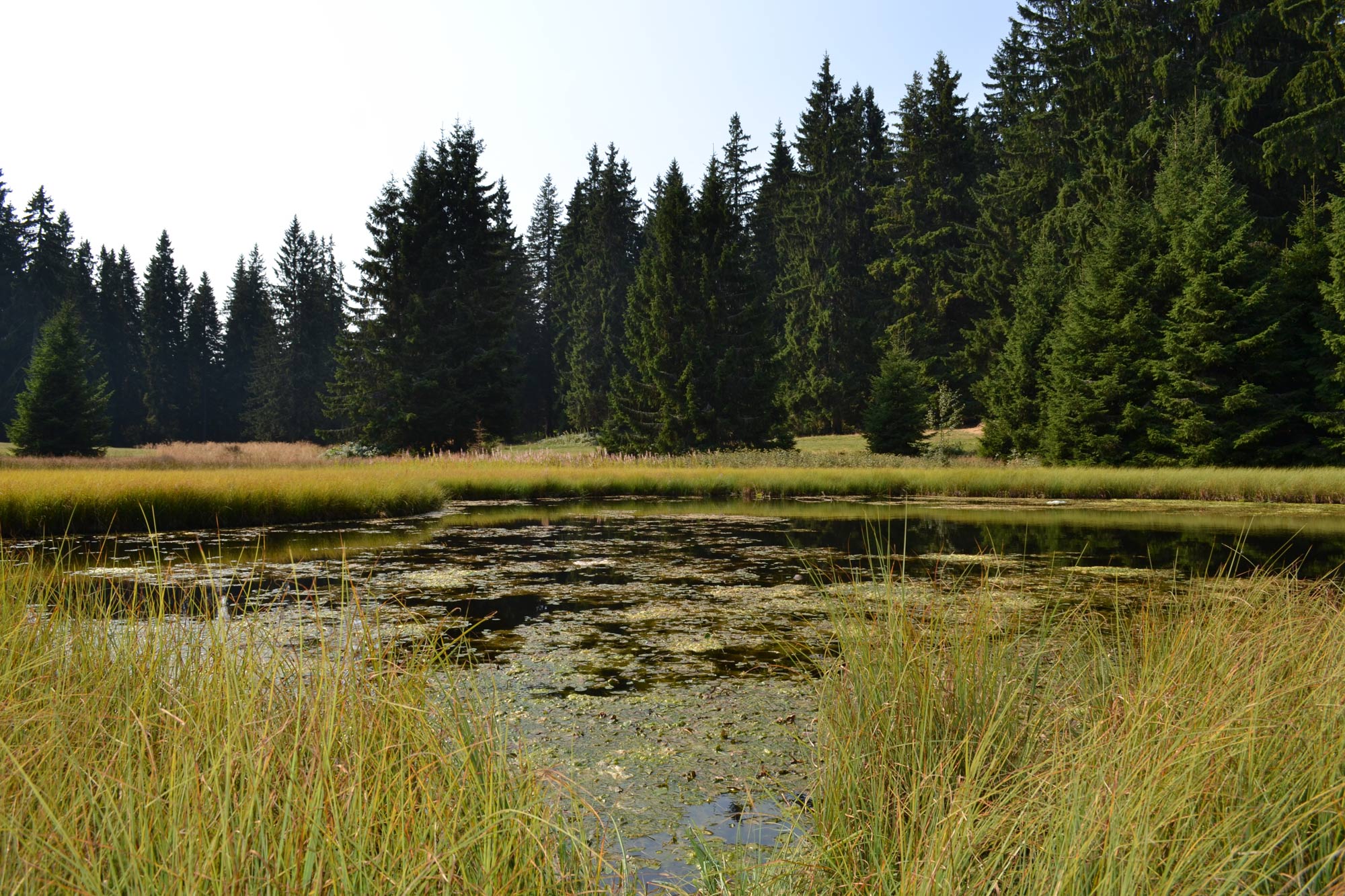
The core of the water flowing into the lake is formed of rain, snow and other weather conditions. The area that is acumulating waters is not so big, yet it is being covered with dense forests, slightely aslope towards the lake, providing constant and gradual water affluence. The major part of the volume of lake waters accumulation is made of melted snow. Snow melting process is gradual and in the forests shade, while for its mountain highs, the process is starting quite late. In these mountain highs, the temperature is on its highest points during period from July to September, while during other months all these areas are rather cold. The winter period there is cold and lasts aproximatelly five to six months, starting from November untill the end of March. During that period, great amounts of snow are accumulated and becouse of the shades under the forest, the melting process may last until June. In the lake area, snow accumulations may keep on melting until the half of May, while frost is lasting even during June. The summer period is shorter there and the process of evaporation of the lake waters is significantly reduced.
Evaporation of lake waters is fairly sustained becouse of humidity in the surrounding area covered with forests, same as for the low average temperature of the air in this climate zone. Also, the vegetational layer, covering the water surface over its greatest part, is preventing evaporations and air currents.
The vegetation cover over the lake is reducing the area of the free water surface exposed to direct insolation and evaporation, impacting significantly the heat reduction of the lake waters. During summer period, accumulated lake waters are formed of rain, quite frequent and affluent in these zones.
Regarding the temperature difference of lake waters, Mr Kosanin assumed that in the deepest parts of the lake there is a little spring, yet there are no evidences of undercurrents in the lake bottoms.
It is hard to assume as well if there are losses in water in the lake bottom areas, considering the lake content is mostly based on water-resistant and nonpermeabile bottom soil. Combining all good factors in such a way, the lake is prevented from evaporation even during the greatest summer heats. In the same manner, conditions for habitat and preservance of water vegetation are formed. Before its pouring into the lake, waters accumulated are flowing for some time on completely flat surface, carrying vegetation material collected on the way. At the same time, quite dense vegetation cover, surrounding the lake, is filtering the waters flowing down to the lake. There are no doubts that the free water surface is gradually reduced while the vegetation surrounding the lake is covering the lake surface area.
Furthermore, surrounding forest is getting thinner so the area around the lake is becoming covered more and more with dried meadow zone. These factors are increasing the insolation process and exposing lake waters to sun radiation, reducing significantly air humidity and exposing the lake to impacts of air currents to a fairly greater extent.
The results of these processes are that the lake waters are evaporating and water heating is increasing. All these factors are creating completely new conditions for the life in lake waters, enabling the life of eventual new habitants in the lake waters area. Relatively small quantity of water in the lake can be even heated above the temperature of the air above the lake if there were no underground watter currents. The lake wather is quite cold even during the summer period. The lake is frozen during the winter period. The factors immensely impacting water temperature are the mountain highs, surrounding area abundant in forests, and relatively short period of insolation during day.
In July, the hottest month of the year, the complete surface of the lake is insolated after 9 am, and from 17 pm it is partially sheltered by forests on its west uphill. Since one part of the lake is in forest shelter during the first part of a day, and the other part is in the shelter during the other part of a day, the heating of lake waters is significantly reduced. For the life of lake vegetation, the factor of major importance, lower temperatures of lake waters are providing higher absorption of natural gas and more conditions for life in the lake zone. All these factors are providing lake waters being abundant in alghe and water plants. However, on the other side, the forests surrounding the lake area, in the same manner, are reducing temperature extremes of the water during the night and day periods.
The lake peat is actually the former part of the lake, that is dried and covered with vegetation. The lake peat is occupying almost the greater space than the free water surface area. The elements of peat vegetation are gradually formed starting from the lake coasts over to the centre of the lake , with the evident pass from the belt of peripheral meadow low grass to the belt of high peats. The process of peats expanding and reduction of free water surface area is quite evident on the complete area of lake coast.
Calm waters are prevailing in the hole of the lake, sustained by trees surrounding the lake and preventing the waves that may affect the water vegetation in the lake. For all these conditions, turning the water surface into the peat was quite fast and proportional. Main elements of the water peat are Sphagnum and Hypnum with their low, dense and evergreen roots, combined with Cerex.
First data on the vegetation content of the peat surrounding this lake was provided by our famous scientist Josif Pancic (1814.- 1888.) That data was collected during his research of the lake realized during 1875. There are no wooden plants in the peat, nor any dicotile plant with already familiar and beautiful flower. Generally, the peat is composed of quite few vegetation specie. There are no plants belonging to groups between the water and soil vegetation content, therefore the peat zone is sharply divided from the zone of dried vegetation. Daicko lake is very abundant in alghae becouse the mountain highs are rather an adequate zone for development and life for these types of vegetation.
Mr Kosanin, during his research and explorations of the lake in 1906.has identified 117 specie and the varieties of 53 types of alghae. The discovering of 28 species of plants with 115 types and varieties was rather significant contribution to science in Serbia at that time. Furthermore, two types and one variety were quite important discoveries for the complete science world. The fauna of Daicko lake is still not explored enough, but so far it is widely known that this lake is the only habitat in Serbia region for three types of water insects of spacie ordonata, dragonflies. The lake is one of the rare habitats of Trituruscristatus.
Antropogenic factor is threatening to distroy this gift of nature. Intensive process of vegetation covering the lake is mainly the result of human negative impact on the nature. Intensive process of cutting forests in the lake surroundings is increasing insolation and evaporation, same as building the road by the lake reduced the amount of lake waters and changed the regime of lake waters. Therefore, becouse of the constant change of ecological conditions, microclimate parameters and water balance, the process of eutrofication of the lake is becoming more invasive. Besides, the negative impacts caused by feeding animals near the lake, and making the soil more dense are changing the hemism of the lake. Once, this lake was used as watering place for animals. During research of Mr Kosanin, one century ago, this lake, resembling of real mountain eye of Golija, was surrounded by dense forests, preventing accumulations of sediments in the lake bottom zone and animals approaching the lake.
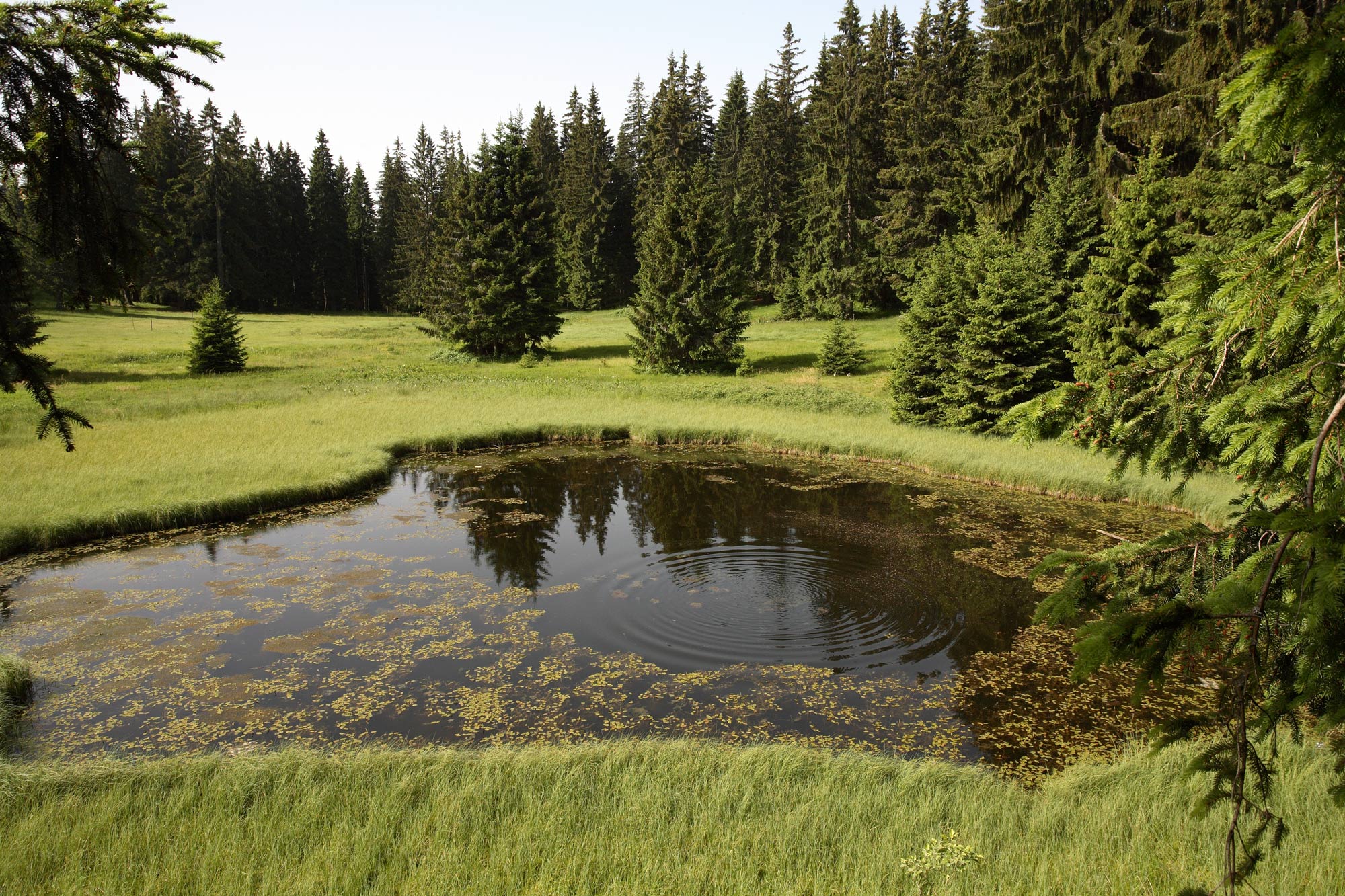
Considering the fact that the lake is on the solid fondation now, increasing the further development of the lake vegetation, it is allowed for animals to appproach the lake. The vegetation in the lake zone surroundings is fairly reducing the size of the lake mirror. The level of changes occurred on Daicko lake can be defined as quite high, and the lake as one completely natural ecosystem.
City government of Ivanjica, supported by National Institute for protecting nature, in 1966. came up with resolution and national agreement considering the protection of Daicko lake-peat, as the heritage of geobotanical character and natural rarity. The resolution applied is covering the lake hole and surrounding area of 2ha in total. The borders of protected zones are planned to be precisely defined and marked, that is still in progress. This lake area is under the high protection regime as the reservate of nature, prevented from any changes that may result in obstacles to natural spontaneous development of this ecosystem. This ban is prohibiting contamination of lake waters and animal feeding in the lake zone.
However, no matter of decision and the ban applied, the ban is not regulary practiced and further degradation of this natural rarity is continued. For technical protection purposes, the project for protection of these areas is including also sediment pockets that would prevent sediments pouring out with the surface water. The protection project includes digging accumulated objects from the lake bottoms. All biological measures applied during the phases of implementation of the project for protection and preservation of flora and fauna of this natural ecosystem are evident in each phase of providing stability for the total of Daicko lake ecosystem. For instance, the survival of spacie great crested newt is in direct relation to the ban on increasing the number of fish in the lake waters, since the survival of this specie would be threatened by predator fishes.
This lake is very popular place for all people living in villages of mountain Golija. According to a legend, most beautiful mountain fairies are gathering on the lake. Once, the lake used to be utilized for religious rituals also. Traditionally, people are gathering there on St Prokopije day, on 21st of July, on the little uphill near the lake. This fair, visited by many people and lovers of Golija is impacting the ecosystem of the lake also. On the memorial stone where is the spring, accros the lake, dedicated to Mr Vlasta Parezanovic, a pioneer of forest engineering in Moravica region, there are words, curved into the stone – If every man would know which tree belongs to him, he would never cut it down.
There are numerous legends about this lake. The most popular one is about wedding witnesses drowning in the lake. Mr Ljubomir Stankovic wrote down the legend that says that wedding witnesses with a girl were passing near the lake. They were all on horses and quite drunk. As they were approaching the coast of the lake, they were disappearing one by one in lake waters. Only the man who was carrying the flag survived. Later on, on the very source of Pakasnica river, whith its spring in the bottoms of the lake, a girl and her brother-in-law appeared. Ever since, on St Prokopije day, people from villages around the lake are gathering there for liturgy and fair.
In the legend about the monster from the lake it is said that some monster was appearing from the waters of Daicko lake from time to time. It would come out of the lake waters, moving through pastures around the lake and attacking bulls and animals that shepherds from the villages around the lake were feeding. Later on, shepherds decided to make a plan how to beat the monster. They asked one blacksmith from Daici to make iron reinforcements over the horns of his bull. The blacksmith was feeding and taking care of his bull that will fight the lake monster. After the fight, where blacksmiths bull beated the monster from the lake, all shepherds were cheerful and happy. The monster falled down into the lake waters and never appeared again in the pastures around the lake. Ever since, shepherds are peacefully feeding their animals near the lake.
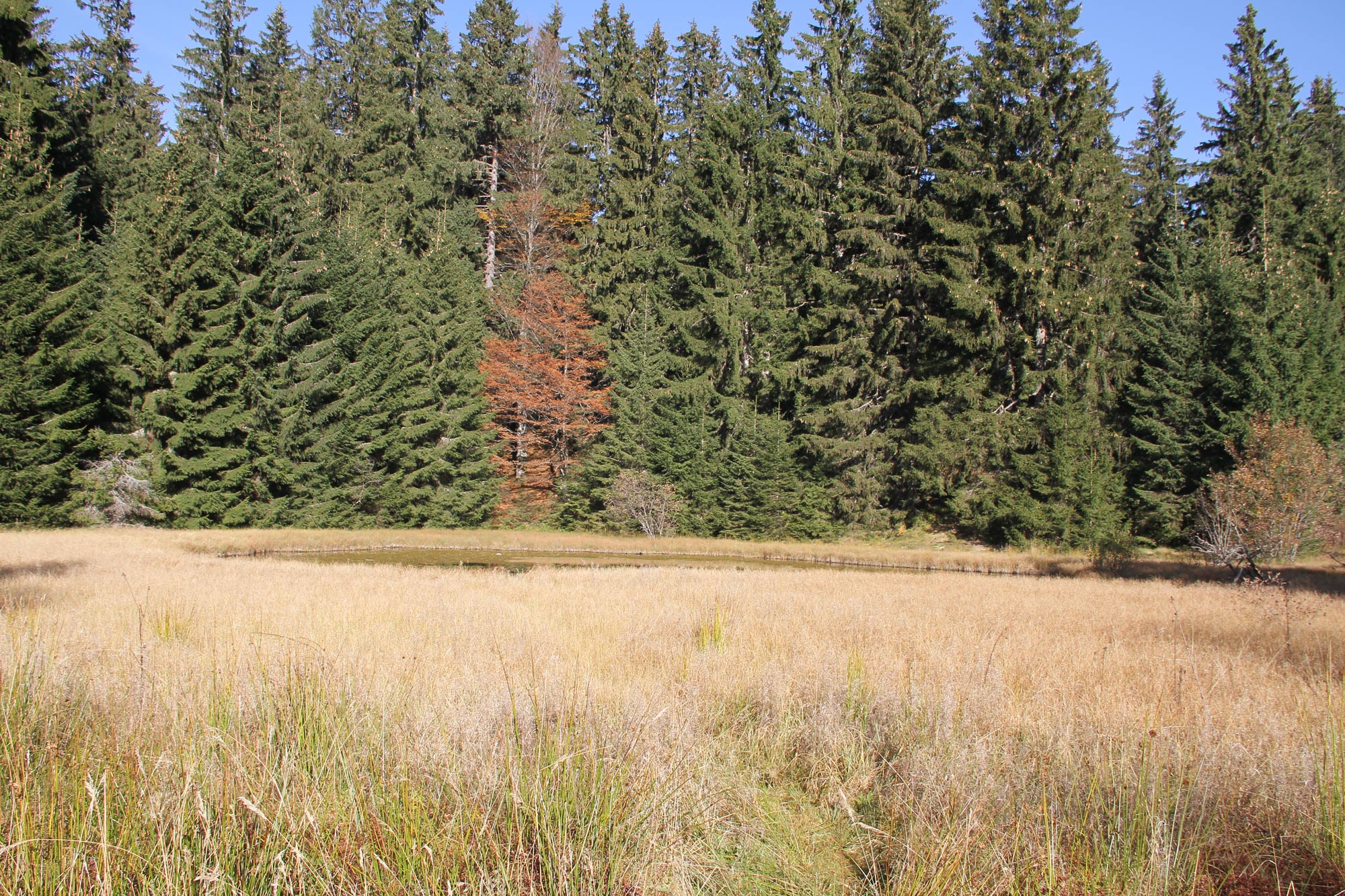
In the legend of Bele Vode, that event was described in the similiar way, after the fight between blacksmiths bull and the monster from Daicko lake,a spring of water, almost 2km far from the lake, full of monster blood started pouring out from the spring. People of these areas used to say that wounded monster coloured the water with its blood. After that, the people living in villages around the lake got scared and asked for a priest to hold liturgy at this spring, in order to clean the water and make it pure as it was before. Many people gathered for this liturgy and, immensely pleasing all people living there, the spring waters got clean again, like used to be once. Every year, on St Prokopije day, people are gathering for great fair in Bele Vode. Once there was held liturgy and nowdays there is a fair.
One more legend is of similiar content. After beating down the monster of Daicko lake, people living in surrounding villages were exposed to hail, mostly village Gledjica. People from Gledjica, after being told from someone from the lake that it might help them save their harvest in that way, decided to ask five priests to hold a liturgy on the lake on St Prokopije day, and declare this saint as their home patron. Ever since, every year there is a fair on the lake , where people are gathering, not only from villages in this area but also people from Moravica and Studenica region.



